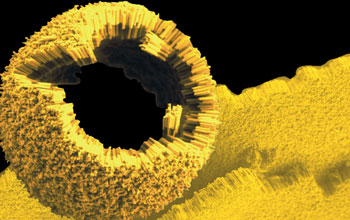Multimedia Gallery
Self-assembly of Gold-polymer Nanorods
This image depicts the self-assembly of gold-polymer nanorods into a curved structure. National Science Foundation (NSF)-supported research by Chad Mirkin of Northwestern University has generated nanostructures with the ability to curve. These are the first nanostructures to exhibit this ability--a critical requirement for the utility of nanomaterials in further applications including drug-delivery systems, nanoscale electronics, catalysts and light-harvesting materials. NSF is the lead agency for the National Nanotechnology Initiative, a multiagency network working to bolster nanotechnology and ensure U.S. dominance in this emerging field. Strong research efforts are critical to capitalizing on nanotechnology's potential to revolutionize science and engineering, and to harness all that it offers.
More about this Image
Inspired by the molecular assembly techniques used in living cells, chemist Chad Mirkin and his colleagues at Northwestern University have created a new class of nanometer-scale building blocks that can spontaneously assemble themselves into ultra-tiny spheres, tubes and curved sheets.
This is the first time that scientists have been able to make structures on this scale that curve in any fashion, as opposed to being straight or flat. Since the Mirkin group can also control the size and curvature of their structures very accurately, the technology could eventually lead to important applications in nanoscale electronics and drug-delivery systems.
Mirkin and his colleagues were supported in part by NSF, and published their discovery in the Jan. 16, 2004, issue of the journal Science. A press release detailing their work is available from Northwestern Here. (Date of Image: December 2003)
Credit: Chad Mirkin, Northwestern University
See other images like this on your iPhone or iPad download NSF Science Zone on the Apple App Store.
Images and other media in the National Science Foundation Multimedia Gallery are available for use in print and electronic material by NSF employees, members of the media, university staff, teachers and the general public. All media in the gallery are intended for personal, educational and nonprofit/non-commercial use only.
Images credited to the National Science Foundation, a federal agency, are in the public domain. The images were created by employees of the United States Government as part of their official duties or prepared by contractors as "works for hire" for NSF. You may freely use NSF-credited images and, at your discretion, credit NSF with a "Courtesy: National Science Foundation" notation.
Additional information about general usage can be found in Conditions.
Also Available:
Download the high-resolution JPG version of the image. (1 MB)
Use your mouse to right-click (Mac users may need to Ctrl-click) the link above and choose the option that will save the file or target to your computer.

